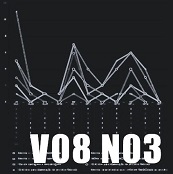Abstract
In the past decades, the increasing number of concert halls with acoustic variability promoted the study of coupled room acoustics. The acoustic variability can be performed in many ways such as coupling a reverberant room to the main theater. Coupled rooms have a unique sound energy decay. Architectural features have a direct influence on the non-exponential sound decay. This study aims to identify and analyze the architectural features and architectural parameters proposed along the years that influence the formation of non-exponential sound decays in coupled rooms. This study was made through a Systematic Literature Review (SLR). Results showed that the combination of three architectural features is responsible for the non-exponential sound decay. The relations between those features resulted in three architectural parameters: Aperture Coupling Area, Volume Rate, and Absorption Rate. Results showed that the SLR was able to present the state of the art of the researched subject and was able to identify the period of most interest in coupled room studies. It also allowed understanding how coupled room theories have been contributing to the understanding of church acoustics and to observe research gaps regarding coupled room psychoacoustics and the architectural parameters Volume Rate and Absorption Rate. It also identified the need for future research on stagehouse coupling in theaters. Results from this work will subsidize future acoustics projects involving coupled room acoustics.References
ANDERSON, J. S.; BRATOS-ANDERSON, M. Acoustic coupling effects in St Paul’s Cathedral, London. Journal of Sound and Vibration, v. 236, n. 2, p. 209–225, 2000. doi: https://doi.org/10.1006/jsvi.1999.2988
ARTEC. Concert Theatres. Disponível em: http://www.artecconsultants.com/03_projects/venue_types/concert_theatres.html. Acesso em: 21 ago. 2017.
BRADLEY, D. T.; WANG, L. M. Comparison of measured and computer-modeled objective parameters for an existing coupled volume concert hall. Building Acoustics, v. 14, n. 2, p. 79–90, 2007. doi: https://doi.org/10.1260/135101007781448028
BRADLEY, D. T.; WANG, L. M. Optimum absorption and aperture parameters for realistic coupled volume spaces determined from computational analysis and subjective testing results. Journal of the Acoustical Society of America, v. 127, n. 1, p. 223–232, 2010. doi: https://doi.org/10.1121/1.3268604
BRADLEY, D. T.; WANG, L. M. Quantifying the double slope effect in coupled volume room systems. Building Acoustics, v. 16, n. 2, p. 105–123, 2009. doi: https://doi.org/10.1260/135101009788913275
BRADLEY, D. T.; WANG, L. M. Room acoustics in coupled volume spaces. In: 2006 ARCHITECTURAL ENGINEERING NATIONAL CONFERENCE. Anais. Omaha, NE, United states, 2006. p. 24-29.
BRADLEY, D. T.; WANG, L. M. The effects of simple coupled volume geometry on the objective and subjective results from nonexponential decay. Journal of the Acoustical Society of America, v. 118, n. 3, p. 1480–1490, 2005. doi:https://doi.org/10.1121/1.1984892
ERMANN, M. Coupled volumes: Aperture size and the double-sloped decay of concert halls. Building Acoustics, v. 12, n. 1, p. 1–14, 2005a. doi: https://doi.org/10.1260/1351010053499252
ERMANN, M. Coupled volumes: Secondary room reverberance and the double-sloped decay of concert halls. Building Acoustics, v. 12, n. 3, p. 165–174, 2005b. doi: https://doi.org/10.1260/135101005774353069
ERMANN, M. Double Sloped Decay: Subjective Listening Test to Determine Perceptibility and Preference. Building Acoustics, v. 14, n. 2, p. 91–107, 2007. doi: https://doi.org/10.1260/135101007781448055
ERMANN, M.; JOHNSON, M. Exposure and materiality of the secondary room and its impact on the impulse response of coupled-volume concert halls. Journal of Sound and Vibration, v. 284, n. 3–5, p. 915–931, 2005. doi:https://doi.org/10.1016/j.jsv.2004.07.030
ESCOLANO, J. et al. A diffusion equation model for investigations on acoustics in coupled-volume systems. In: MEETINGS ON ACOUSTICS. Proceedings... Montreal, QC, Canada, 2013.
EYRING, C. F. Reverberation time measurements in coupled rooms. Journal of the Acoustical Society of America, v. 3, n. 2A, p. 181–206, 1931. doi: https://doi.org/10.1121/1.1915555
GARAI, M. et al. Acoustic measurements in eleven Italian opera houses: Correlations between room criteria and considerations on the local evolution of a typology. Building and Environment, v. 94, Part 2, p. 900–912, 2015. doi:https://doi.org/10.1016/j.buildenv.2015.07.026
JEONG, D.; JOO, H. Prediction of reverberance in rooms with simulated non-single-exponential sound decays. Applied Acoustics, v. 125, p. 136–146, 2017. doi: https://doi.org/10.1016/j.apacoust.2017.04.018
JOHNSON, R.; KAHLE, E.; ESSERT, R. Variable coupled cubage for music performance. In: MUSIC AND CONCERT HALL ACOUSTICS CONFERENCE. Anais... Japan, 1995.
KITCHENHAM, B. Procedures for Performing Systematic Reviews, 2004. 28 p. (Keele University Technical Report TR/SE-0401).
LUIZARD, P.; KATZ, B. F. G. Investigation of the effective aperture area of sliding and hinged doors between coupled spaces. Journal of the Acoustical Society of America, v. 136, n. 2, p. EL135-EL141, 2014. doi: https://doi.org/10.1121/1.4890202
LUIZARD, P.; KATZ, B. F. G.; GUASTAVINO, C. Perceptual thresholds for realistic double-slope decay reverberation in large coupled spaces. Journal of the Acoustical Society of America, v. 137, n. 1, p. 75–84, 2015.
MARTELLOTTA, F. Identifying acoustical coupling by measurements and prediction-models for St. Peter’s Basilica in Rome. Journal of the Acoustical Society of America, v. 126, n. 3, p. 1175–1186, 2009. doi: https://doi.org/10.1121/1.4904515
MARTELLOTTA, F. Understanding the acoustics of Papal Basilicas in Rome by means of a coupled-volumes approach. Journal of Sound and Vibration, v. 382, p. 413–427, 2016. doi: https://doi.org/10.1016/j.jsv.2016.07.007
MEISSNER, M. Computer modelling of coupled spaces: Variations of eigenmodes frequency due to a change in coupling area. Archives of Acoustics, v. 34, n. 2, p. 157–168, 2009. Disponível em http://acoustics.ippt.gov.pl/index.php/aa/article/view/572. Acesso em: 22 de Jan. de 2018.
PU, H.; QIU, X.; WANG, J. Different sound decay patterns and energy feedback in coupled volumes. Journal of the Acoustical Society of America, v. 129, n. 4, p. 1972–1980, 2011. doi: https://doi.org/10.1121/1.3553223
SABINE, W. C. Collected papers on acoustics. London, U.K.: Cambridge : Harvard University Press, 1922.
XIANG, N. et al. Investigation on the effect of aperture sizes and receiver positions in coupled rooms. Journal of the Acoustical Society of America, v. 133, n. 6, p. 3975–3985, 2013. doi: https://doi.org/10.1121/1.4802740
I accept that PARC Research in Architecture and Building Construction journal perform, on the original file approved for publication, revisions and modifications in orthoghaphic, grammar and standard issues.
I give to PARC Research in Architecture and Building Construction journal the rights of first publication of the revised version of my paper, licensed under the 'Creative Commons Attribution' license (which allows sharing the work with the recognition of first authorship and publication in this journal).

